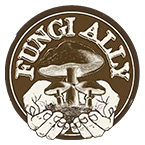Have you ever wondered about the notion of where do mushrooms come from? If so, you are not alone! Check out this video to learn more about it, including what mycelium is
Many people become amazed by mushrooms, particularly when they stumble across these magnificent beings while walking through the woods or around their yard.
It can seem like an amazing phenomenon; the appearance that mushrooms seemingly come out of nowhere and then are gone after a week or two.
So where do mushrooms come from? How do they pop up? And what is mycelium?
The video below helps to answer the question, “Where do mushrooms come from?” Check it out now for a better understanding, and an example that utilizes one of our beautiful and delicious pink oyster mushrooms. Want to experience the explosion of mushrooms from mycelium? Check out one of our mushroom growing kits.
Where our pink oyster mushrooms (and all other mushrooms) come from
As you can see in the video, our pink oyster mushrooms are growing from mycelium in a clear plastic bag. However, in nature, this mycelium is located elsewhere, like in the ground or a nearby tree. Somewhere we can’t normally see it as easily.
The mystery of mushrooms typically develops as we mainly cannot see the mycelium when we’re out in the woods or around our yard.
The fruiting body of the mushroom, which comes from the mycelium, is what really gets us to even realize there was some mycelial mass in the area.
In reality, the mushroom is always around when the mycelial network exists in the area.
A deeper dive on mycelium
Mycelium is a powerful organism. It is how fungi spends most of its life.
When wondering about mycelium one must learn about the important role mycelium plays in mycology, plant pathology, and mushroom cultivation. Only by studying and understanding the physiology of mycelium has mushroom cultivation been able to occur. However, in recent decades scientists have begun to realize that the mycelium plays an increasingly more important role in ecosystems than ever considered before. Mycelium is not only growing and consuming for the survival of its own species but also for the benefit of the entire ecosystem.
An interesting thing about mycelium is that it only has one cell wall. As humans, we have seven or eight layers of cell. Mycelium only has one, which makes it very susceptible to drying out. This is why you’ll rarely see it exposed. However, you can find it by kicking over some leaves or rolling over logs. You’ll find it where it is moist. It needs to be in a place where there is high humidity.
Mycelium excretes enzymes into its surroundings. These enzymes help the mycelium break down the food it is growing in including logs, trees, wood chips, leaves, or whatever substrate. The enzymes go outside the mycelial body and start to break down the substrate into basic compounds like carbon and nitrogen. Then those compounds are sucked into the mycelial body and are incorporated into the fungal organism.
Once the time is right for fruiting, meaning the environmental conditions are appropriate or stress takes place from a competing organism, then the mycelial network will fruit a mushroom. The fruiting body will become visible above ground and you will be able to see it.
And if you’re lucky, it will be a delicious, gourmet mushrooms like one of the strains we grow!
The enzymatic language
The mushroom begins in the mycelial network. However, the enzymes are incredibly important in the evolution from mycelial mass to mushroom.
Two amazing feats from these enzymes include enzymatic language and healthful properties.
These enzymes, depending on what comes back to the mycelium, will guide how the mycelium grows. If the mycelium is receiving compounds that it really likes and helps it grow quicker, then the enzymes will take note and work on proliferating more in that area. If the enzymatic language signals an attack, then the enzymes will secrete in defense.
These enzymes can be very potent antibiotic, antiviral, and anti fungal compounds, Humans share a lot similar pathogens as fungi, so many original pharmaceuticals were derived from fungi because mycelium secretes these powerful enzymes with healthful properties that can help fight off harmful pathogens.
So where do mushrooms come from? They come from this powerful, alive mycelial network, typically hidden from our eyes. Then, once the conditions are appropriate, the fruiting body of the mushroom will appear.
Want to grow your own mushrooms? We have a wide variety of mushroom spawn, including grain spawn, plug spawn, sawdust spawn, and ready-to-fruit mushroom growing kits. Using any of these mushroom growing supplies will help you develop your own relationship with mycelium, which you will see plenty of while growing your own mushrooms at home.

